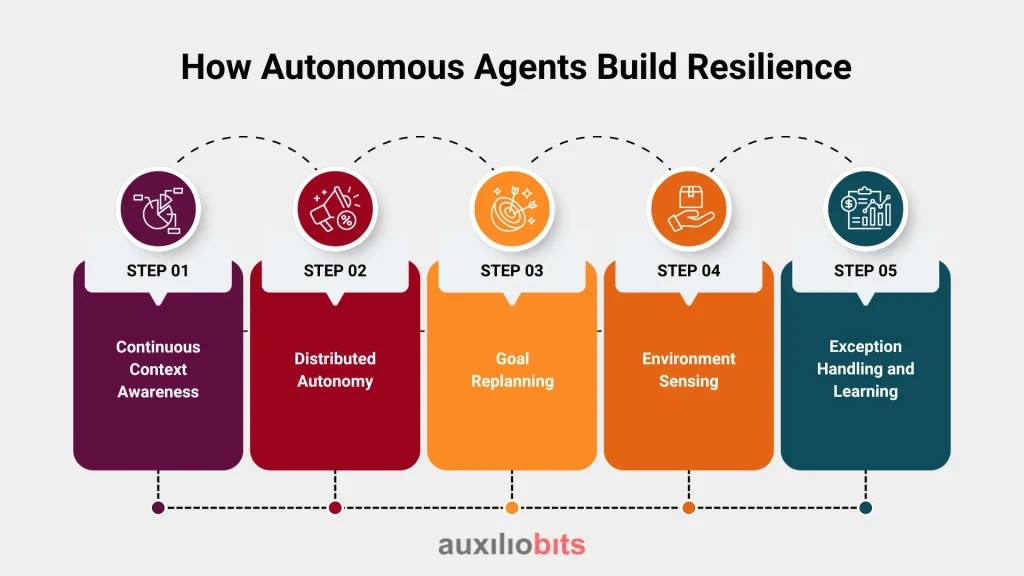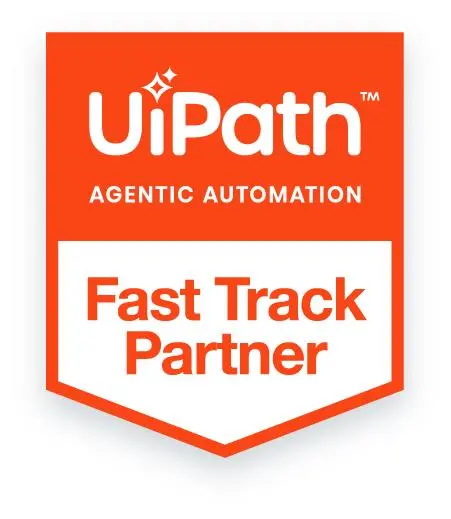
Key Takeaways
- Business process resilience requires real-time adaptability, not just static redundancy.
- Autonomous agents are context-aware, goal-driven entities that learn and adapt over time.
- They improve resilience through dynamic replanning, collaboration, and self-healing actions.
- Adoption requires attention to architecture, trust models, and agent governance.
- The future belongs to enterprises with cognitive, agentic infrastructure, ot rule-based bots.
As global supply chains break, customer behaviors shift overnight, and regulatory landscapes evolve rapidly, enterprises need something more than just automation—they need resilience. Traditional business continuity plans (BCPs) and reactive workflows no longer suffice. Enter autonomous agents: a new breed of AI entities capable of perception, decision-making, goal pursuit, and self-correction.
While most enterprises are aware of RPA or workflow engines, few understand how autonomous agents unlock a dynamic form of resilience that static systems simply cannot offer.
Also read: Transitioning from Rule-Based Bots to Intelligent Agentic AI.
What Is Business Process Resilience?
Business process resilience refers to a business’s ability to absorb shocks, adapt to disruptions, and continue delivering value with minimal downtime. It extends beyond continuity, focusing on adaptation, flexibility, and proactive mitigation.
Resilience ≠ Redundancy.
Adding more servers or duplicating processes is not the same as having adaptive systems that learn from disruptions and evolve.
Enter Autonomous Agents: A Paradigm Shift
Autonomous agents differ from conventional automation bots. Instead of relying on rigid rule sets, they function as goal-driven software entities that:
- Perceive their environment (e.g., API responses, event triggers)
- Reason based on the current context and past outcomes
- Act autonomously to achieve goals (e.g., fulfilling an order, resolving a customer complaint)
- Learn from feedback loops and evolve their decision-making
They are the foundation of Agentic AI, where agents don’t just execute tasks—they orchestrate, collaborate, and optimize processes in real time.
Core Attributes of Resilient Business Processes
Before diving into how agents enable resilience, it’s crucial to understand what resilient processes require:
| Attribute | Description |
| Flexibility | Can adapt workflows without hard-coded logic |
| Visibility | Provide real-time situational awareness |
| Self-Healing | Detect and correct anomalies on their own |
| Goal Orientation | Focus on outcomes, not just tasks |
| Continuity | Operate seamlessly even during outages or changes |
Traditional bots fail most of these tests—autonomous agents pass them.
How Autonomous Agents Build Resilience
Let’s explore the specific mechanisms through which autonomous agents improve business process resilience.

1. Continuous Context Awareness
Agents persist in memory and track changing variables over time (e.g., inventory levels, SLA windows). This temporal awareness allows them to:
- Anticipate issues (like stockouts or SLA breaches)
- Redirect flows dynamically (e.g., route orders to different suppliers)
2 Distributed Autonomy
Unlike centralized bots or BPM engines, autonomous agents work in decentralized clusters. If one agent fails, others can assume control, ensuring continuity of operations.
3. Goal Replanning
Agents aren’t confined to “if-this-then-that” logic. They use goal trees or semantic planning graphs dynamically to reconfigure their activity if original plans fail.
4. Environment Sensing
Autonomous agents interface with APIs, databases, and event streams. For example, in procurement:
- If a supplier API goes down,
- The agent can automatically switch to alternate suppliers.
- While flagging the anomaly to a human supervisor.
5. Exception Handling and Learning
Unlike RPA bots that fail on unexpected UI changes, agents can:
- Detect anomalies
- Pull in historical data for pattern recognition.
- Suggest (or even take) corrective actions, like escalating to the right stakeholder or initiating a retry with modified parameters
Real-World Use Cases
AI agents are being increasingly deployed across various industries to streamline operations, reduce human intervention, and enable real-time decision-making. Here are some real-world use cases demonstrating their impact across key sectors:
Healthcare:
AI agents manage complex patient referral workflows between hospitals, clinics, and insurance providers. For instance, if a necessary document is missing or a data field is inaccurately filled, the agent identifies the issue, automatically requests the correction, and resumes processing without needing human involvement. This drastically reduces delays and improves coordination across payer and provider systems.
Manufacturing:
In manufacturing environments, autonomous agents continuously monitor equipment telemetry data to detect early signs of failure or performance degradation. Suppose a vibration anomaly or irregular pattern is identified. In that case, the agent proactively schedules predictive maintenance, reroutes production lines to avoid downtime, and informs supply chain systems to adjust delivery timelines or resource allocation accordingly.
Banking:
AI agents are revolutionizing fraud detection by analyzing behavioral anomalies in real-time. These agents work across multiple systems—credit scoring, Know Your Customer (KYC) validation, and transaction monitoring—to identify inconsistencies and coordinate responses. Upon detecting suspicious activity, they can autonomously freeze accounts, initiate alerts, or request additional verification to mitigate risk without manual oversight.
Under-the-Radar Advantages
While the headline benefits of autonomous agents—like speed, efficiency, and cost reduction—are well known, several lesser-discussed yet highly impactful capabilities contribute significantly to system resilience. These subtle advantages are often overlooked in traditional automation narratives, but they are critical in enabling adaptive and robust enterprise operations.
Meta-Reasoning
One of the most potent yet understated features of autonomous agents is meta-reasoning—the ability to think about their reasoning process. This means agents can evaluate the effectiveness of their own decisions and strategies in real-time. If the results of an action sequence fall below expected thresholds, the agent doesn’t simply fail or wait for human intervention. Instead, it can dynamically reassess the situation, adjust its goals, or switch strategies to achieve the desired outcome.
This kind of self-awareness enables agents to recover from errors, prevent cascading failures, and continually improve their performance—something traditional RPA bots or scripted automations cannot achieve.
Example: In a logistics environment, if a delivery routing agent notices delays piling up beyond acceptable limits, it can reconfigure delivery priorities, optimize new routes, or even request collaboration from other agents in the system to distribute the load.
Recursive Collaboration
Autonomous agents are not isolated problem-solvers—they can collaborate recursively. This means an agent can decompose a complex task into smaller subtasks, delegate those to specialized peer agents, and then evaluate the results of each before aggregating them into a final solution. This recursive delegation and result validation create a multi-layered, resilient problem-solving mesh. Even if one agent fails or underperforms, others can compensate or reroute the workflow without disruption.
Example: In financial services, a credit approval agent can delegate fraud checks, income validation, and identity verification to respective agents. It waits for their responses, evaluates the integrity of the inputs, and then makes a final lending decision. If one check fails, it can re-initiate or escalate intelligently.
Cross-System Cohesion
Another hidden superpower of agentic AI is its ability to eliminate fragile integrations by serving as intelligent glue across disparate enterprise systems. Agents can work across legacy ERP platforms, real-time data pipelines (like P-ERCM), ticketing systems, CRMs, and cloud APIs—without the brittleness of hardcoded workflows. Because they understand context and intent, agents can dynamically adapt to changes such as new API versions, modified data schemas, or altered workflows without needing reprogramming.
Example: In IT service management, if an API for the incident management system changes due to a platform upgrade, a traditional automation would fail. But an autonomous agent can detect the change, explore the new schema or endpoint, remap its internal logic, and continue resolving tickets without escalation or downtime.
Key Architectural Considerations
Building agent-based resilience isn’t just a plug-and-play approach. Considerations include:
- Stateful Agent Design: Should agents maintain long-term context or be stateless for scale?
- Goal Management System: How are goals assigned, tracked, and modified mid-flight?
- Semantic Memory Integration: Use vector databases for contextual memory and RAG (Retrieval-Augmented Generation) for reasoning
- Trust and Ethics Frameworks: Build agent guardrails for escalation policies, ethical action boundaries, and data sensitivity.
Implementation Challenges and How to Overcome Them
| Challenge | Mitigation Strategy |
| Over-engineering risk | Start with a minimal viable agent, iterate. |
| Complex system integration: Utilize | Use low-code orchestration layers, such as ike LangGraph, Microsoft Power Platform, or Node-RED. |
| Human-agent conflict | Introduce collaborative interfaces (agent copilots) rather than agent-only execution. |
| Lack of training data | Use synthetic data generation and simulations to bootstrap learning. |
Future Outlook: Toward Cognitive Enterprise Resilience
The evolution is moving toward multi-agent cognitive ecosystems, where:
- Agents simulate outcomes before acting (like a mental model).
- They negotiate goals among departments or teams.
- Organizations operate as adaptive AI fabrics, rather than command-and-control hierarchies.
These systems will eventually be able to predict disruptions, propose mitigation paths, and negotiate tradeoffs—all autonomously.
Final Thoughts
Enterprises that still rely on deterministic automation or “wait-until-it-breaks” BCP strategies will fall behind. The future is dynamic, volatile, and uncertain—and only those who build adaptive, agent-powered systems will thrive.
Autonomous agents provide more than efficiency—they bring awareness, collaboration, adaptability, and foresight. That’s not just automation. That’s resilience.








